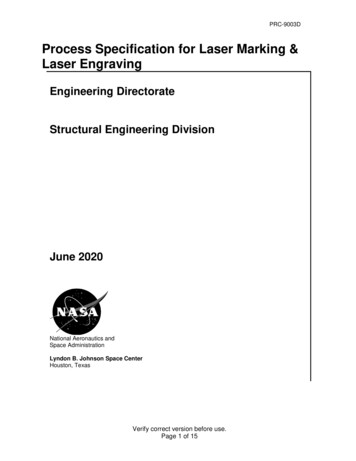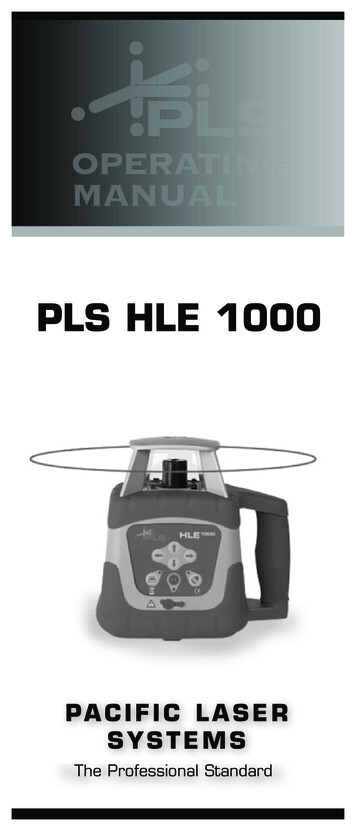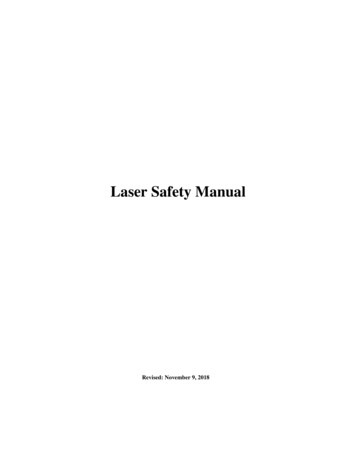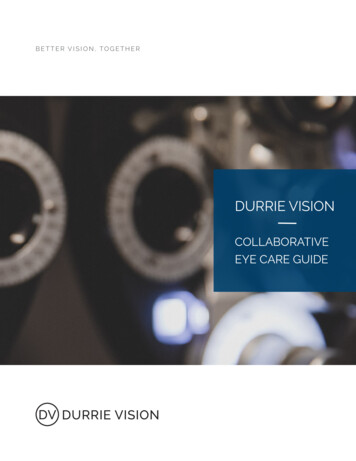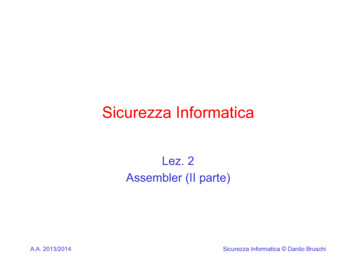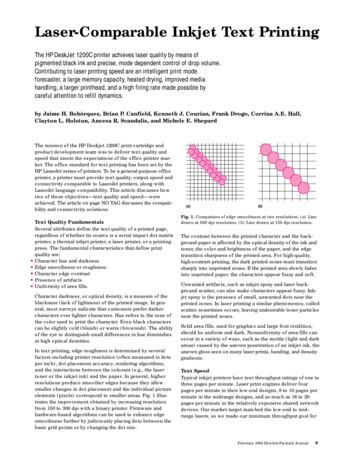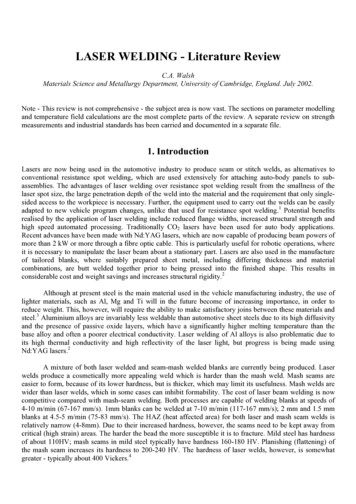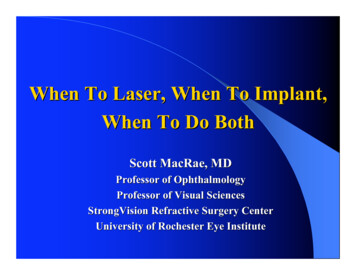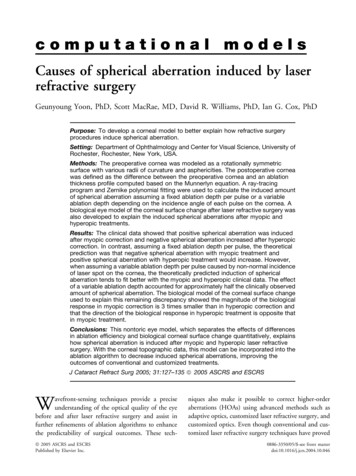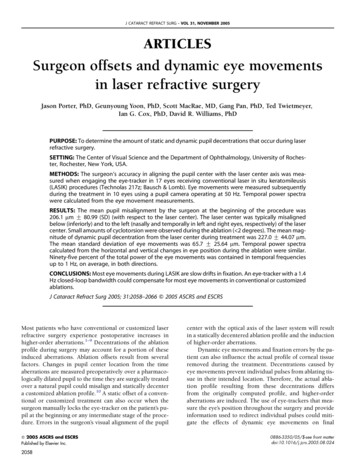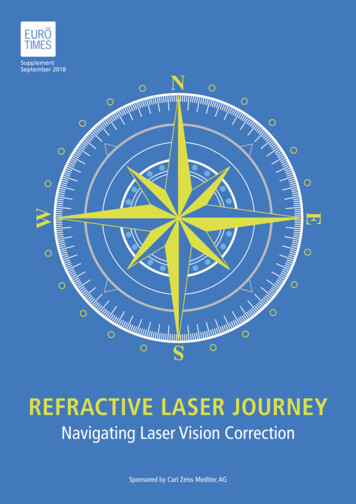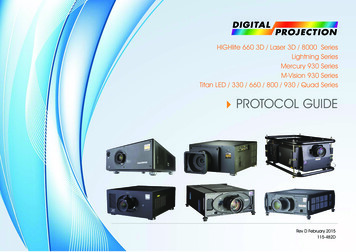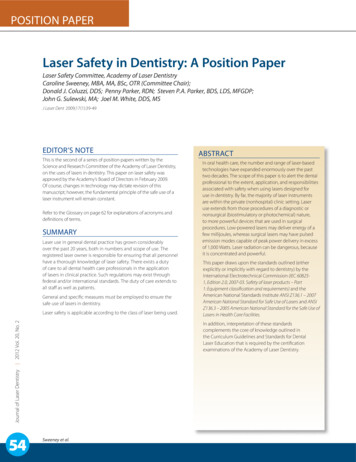
Transcription
POSITION PAPERLaser Safety in Dentistry: A Position PaperLaser Safety Committee, Academy of Laser DentistryCaroline Sweeney, MBA, MA, BSc, OTR (Committee Chair);Donald J. Coluzzi, DDS; Penny Parker, RDN; Steven P.A. Parker, BDS, LDS, MFGDP;John G. Sulewski, MA; Joel M. White, DDS, MSJ Laser Dent 2009;17(1):39-49EDITOR’S NOTEThis is the second of a series of position papers written by theScience and Research Committee of the Academy of Laser Dentistry,on the uses of lasers in dentistry. This paper on laser safety wasapproved by the Academy’s Board of Directors in February 2009.Of course, changes in technology may dictate revision of thismanuscript; however, the fundamental principle of the safe use of alaser instrument will remain constant.Refer to the Glossary on page 62 for explanations of acronyms anddefinitions of terms.SUMMARYLaser use in general dental practice has grown considerablyover the past 20 years, both in numbers and scope of use. Theregistered laser owner is responsible for ensuring that all personnelhave a thorough knowledge of laser safety. There exists a dutyof care to all dental health care professionals in the applicationof lasers in clinical practice. Such regulations may exist throughfederal and/or international standards. The duty of care extends toall staff as well as patients.General and specific measures must be employed to ensure thesafe use of lasers in dentistry.Journal of Laser Dentistry 2012 Vol. 20, No. 2Laser safety is applicable according to the class of laser being used.54abstractIn oral health care, the number and range of laser-basedtechnologies have expanded enormously over the pasttwo decades. The scope of this paper is to alert the dentalprofessional to the extent, application, and responsibilitiesassociated with safety when using lasers designed foruse in dentistry. By far, the majority of laser instrumentsare within the private (nonhospital) clinic setting. Laseruse extends from those procedures of a diagnostic ornonsurgical (biostimulatory or photochemical) nature,to more powerful devices that are used in surgicalprocedures. Low-powered lasers may deliver energy of afew millijoules, whereas surgical lasers may have pulsedemission modes capable of peak power delivery in excessof 1,000 Watts. Laser radiation can be dangerous, becauseit is concentrated and powerful.This paper draws upon the standards outlined (eitherexplicitly or implicitly with regard to dentistry) by theInternational Electrotechnical Commission (IEC 608251, Edition 2.0, 2007-03. Safety of laser products – Part1: Equipment classification and requirements) and theAmerican National Standards Institute ANSI Z136.1 – 2007American National Standard for Safe Use of Lasers and ANSIZ136.3 – 2005 American National Standard for the Safe Use ofLasers in Health Care Facilities.In addition, interpretation of these standardscomplements the core of knowledge outlined inthe Curriculum Guidelines and Standards for DentalLaser Education that is required by the certificationexaminations of the Academy of Laser Dentistry.Sweeney et al.
POSITION PAPERINTRODUCTIONLASER CLASSIFICATIONSThere is a basic requirement of the clinician and associated staff toensure that laser use is carried out within a safe environment. Keyto this requirement is an understanding of the device being used,laser physics, and adherence to federal, national, and internationalstatutes. These regulations may apply either specifically to laseruse or within broader health and safety legislation.All lasers used in dentistry are categorized with regard to thepotential for damage, extending from Class I lasers, which maypose no implicit risk, to Class IV lasers for which all safety measuresare applicable.4 Regardless of the class of laser being used, it isadvised that one should never look directly into a laser beam, evenif it is considered to be “eye-safe.” The classification ascends fromClass I through Class IV, with Class I being considered eye-safe andClass IV being the most dangerous. However, with the increaseduse of magnification devices – loupes and microscopes – thereis a potential for laser beams to be magnified and/or focused.Consequently, Class IM and Class IIM contain refinements.History can provide us with records of injuries occurring to peopledue to lasers. The U.S. military, FDA, U.S. Department of Energy, U.K.Medicines and Healthcare Regulatory Agency, and Rockwell LaserIndustries, to name a few, maintain logs of laser-related incidentsthrough their device-reporting mechanisms. The followinganecdotes provide us with some insight into the extent of injuriesand consequences of such accidents. Incidents include lasersthat fail to stop after the foot pedal has been released; burns tolips, tongue, and cheeks; firemen entering a surgery in responseto a smoke alarm, unaware that a laser was in operation.1 Otherincidents include injuries due to the laser beam being reflected offa droplet.1 Incidents specific to eyes include an injury because themanufacturer sent the doctor the wrong goggles specific to thelaser wavelength being used and the doctor did not double-checkthe eyewear designation.2 Another recorded incident involveda university assistant suing for 39 million after she sustained alaser eye injury in a laboratory setting. A key factor in her casewas that the professors were reported as not adhering to wearingthe safety goggles, giving subordinates the impression that theprotective eyewear was not necessary. The assistant settled for 1 million.3 These are just some examples of the nature of laserinjuries that can occur, the majority of which can be traced back topoor adherence to established safety protocols.Class IIIR and IIIB lasers are generally low-level instruments, whosewavelengths are in the red part of the electromagnetic spectrumand whose energy range lies between 1 and 500 milliWatts. Theyrequire safety personnel to monitor the Nominal Hazard Zone(NHZ), eye protection, and training.Class IIIR was recognized to include those continuous-wave lasersthat may emit up to five times the power of Class I and II lasers.5These lasers pose significant risk of eye damage, and the eyewearmust be rated at minimum Optical Density (OD) in the UnitedStates (U.S.) or European L6A standard. It is the laser manufacturer’sresponsibility to provide the numerical value of the OD, in theoperator’s manual, specific to the laser being used.Table 1 provides an outline of the basic classes of lasers, thedelineated emission parameters, examples of uses of each classwithin dentistry, risks posed to unprotected tissue, and safetymeasures. For clarification, it should be noted that the blinkresponse is one of the responses that is encompassed within theaversion response. The aversion response consists of blinking andturning one’s head away from the beam path.Class IV lasers, which are surgical devices, require safety personnelto monitor the NHZ, eye protection, and training. These laserspose significant risk of damage to eyes, any nontarget tissue,and can produce plume hazards. Plume, in the context of thispaper, is defined as the gaseous by-products and debris fromlaser-tissue interaction. It can have a smoky appearance or becompletely invisible to the naked eye. With Class IV lasers, eyewearmust be rated at a minimum OD 5. It is the laser manufacturer’sresponsibility to ensure that the device class is clearly marked onthe laser machine and in certain countries it is required to postsuch information at all access points to the area in which the laseris being operated. It is the responsibility of the Laser Safety Officer(LSO) to ensure that the safety measures appropriate to eachlaser class are applied and made known to all staff. It is not themanufacturer’s responsibility to provide the dentist with trainingin this aspect. However, in the United States, federal regulationsrequire manufacturers to provide certain safety information relatedto their laser in the laser operator’s manual. The computation,in feet or meters, of the NHZ of the laser is a calculation that isgenerally beyond the scope of the dentist or LSO. Monitoringand calculating the NHZ are two different issues. It is themanufacturers’ responsibility to calculate what the NHZ distanceis and have that information posted in the operator’s manual. It isthe LSO’s responsibility to read the manual, ensure that the NHZaround the laser in the dental practice is identified, and personneladhere to the safety measures.Sweeney et al.Journal of Laser Dentistry 2012 Vol. 20,No. 2Laser safety considerations are proportional to established andrecognized risk. The potential maximum power output willdefine a basic approach, but specific to more powerful lasersare measures taken to address additional risks of laser damageto nontarget oral tissue, skin, and eyes. Such damage may bethe result of direct exposure to the laser beam or through thecombustion of chemicals, gases, and materials used in dentistry.The protection of those personnel involved in laser treatment –patient and staff – is a prime consideration, but it is also importantto consider those measures required to safeguard against anyrisk events.55
POSITION PAPERTable 1: Laser Classification, Power Output, and Risk Analysis4Laser ClassClass IMaximumOutput40 µWatts (blue)Use inDentistryLaser caries detectionClass IM400 µWatts (red)ScannerClass II1.0 milliWattAiming beamsLaser caries detectionClass IIIBNo implicit riskPossible risk withmagnified beam(Class IM)Possible risk withdirect viewingSafetyMeasuresBlink responseLaser safety labelsSight aversion responseLaser safety labelsSignificant risk withmagnified beam(Class IIM)Class IIMClass IIIRPossibleHazardVisible 5.0 milliWattsAiming beamsEye damageSafety eyewearInvisible 2.0 milliWattsLow-level lasersEye damageSafety icesMaximum output maypose slight fire andskin riskTraining for Class IIIR and IIIB lasersEye and skin damageSafety eyewearNontarget tissuedamageSafety personnel0.5 WattMucosal scanningchemofluorescentdevicesClass IVNo upper limitAll surgical lasersFire hazardPlume hazardJournal of Laser Dentistry 2012 Vol. 20, No. 2HAZARDS56Laser devices, regardless of class, should be handled with care.With regard to those classes – IIIB and IV – that pose predictable orinstantaneous risk, there are dangers associated not only with thelaser beam itself, but also arising from the device (electrical, cables,air and/or water supplies) and chemicals either associated with thelaser or the ablation of target tissue. Laser hazards may be listedas follows: Optical Nontarget oral tissue Skin Chemical Fire Other collective hazards.The concept of laser beam collimation may be consideredtheoretical, as in practice most laser beams exiting a deliverysystem will undergo some divergence with distance. Based on thepower output, amount of divergence, and beam diameter andconfiguration, a Nominal Ocular Hazard Distance (NOHD) can beassessed.7Sweeney et al.Training and local rulesPossible registration to comply with nationalregulationsThe possible risk to human tissue is assessed with regard to theMaximum Permissible Exposure (MPE). This is a value of exposurelimit above which tissue damage may occur. The MPE value can beapplied relative to laser wavelength, power output, beam diameter,possible focusing of the beam, and target and nontarget tissueor structures.8-9Within a certain space around a Class IV laser, the level of laserradiation that a person is being exposed to is above the MPE.Within this area, called the Nominal Hazard Zone (NHZ), protectivemeasures must be taken. Many factors determine how large theNHZ area is. For example, an 810-nm diode laser with a maximumpower output of 3 Watts will have a different NHZ than another 810nm diode laser with 5 Watts of maximum output power.Therefore, it is not correct to say that the NHZ for an 810-nm diodelaser is, for example, 8 feet for all diode lasers. The same can also besaid for other laser wavelengths; it is incorrect to say that the NHZfor all Er:YAG lasers is 2 feet. The manufacturer has the responsibilityof informing the dentist and LSO of the dental laser’s specific NHZby publishing this information in the operator’s manual.
POSITION PAPEREYE HAZARDSConsequently, it is mandatory that all personnel (clinician,assistant, and patient) within the controlled area of Class IIIB, IIIR,and IV laser use should employ suitable eye protection during laserprocedures. Measures must be taken to protect the eyes of thestaff and patients when the MPE is exceeded, i.e., when the dentallaser is on and people are within the NHZ. Eyewear should beconstructed of wavelength-specific material to attenuate the laserenergy or to contain the energy within MPE values. Standards thatspecify the nature and suitability of laser protective eyewear arecontained in ANSI (ANSI Z136.1 – 2007) for North American users, EN207/208 for European users, and IEC (IEC 60825) for all other regions.The manufacturer’s mark must be imprinted on the eyewear. Thewavelength or wavelengths that the protective eyewear is specificfor must be stamped on the glass or side shields. If the eyewearis marked as 810 nm – 2890 nm, then this means that the eyesexposed to all wavelengths between these two outer limits areprotected. If one line states 810 nm and then underneath 2890 nmis stamped, it means that eyes are protected only against these twowavelengths and no protection is provided for wavelengthsin between.Figure 1: Prime risk structures of the eye at risk vs. laser wavelength (nm).Graphic produced by Dr. Steven Parker.The protocol for use is “patient first on and last off.” This meansthat as soon as the patient is seated in the dental chair, he or she isto put on the appropriate laser eyewear, which is not to be takenoff until the patient is leaving the dental operatory at the end of theprocedure. The dental operatory personnel must don the eyewearprior to the laser being turned on and not take them off until thelaser is switched off or put into standby mode.Care must be taken when cleaning laser eyewear and sideshields so that their protective coating is not destroyed. Theeyewear should be washed with antibacterial soap and dried with asoft cotton cloth in between procedures and patients. Disinfectingsolutions generally applied to dental surfaces are too caustic andshould be avoided. The eyewear must be inspected frequentlyto determine whether there is any breakdown (lifting / cracking /flaking) of the protective material that would render the eyewear tobe useless.Journal of Laser Dentistry 2012 Vol. 20, No. 2The eye is composed of pigmented and nonpigmented tissue thatwill absorb incident laser radiation relative to the wavelength beingused. Damage from a laser beam may be due to direct exposureof the unprotected eye or diffuse reflection and is ever-present inthose situations where wavelength-specific protective eyewear isnot worn. Damage also depends on the type of laser being used,since a free-running pulsed laser will cause more damage thana continuous laser of equal power.10 This is because the outputpower of a free-running pulsed laser can achieve high peak powersurges in a short pulse followed by long off-time durations. Its peakpower is considerably greater than its average output power. For acontinuous-wave laser, the output power and the peak power arethe same, regardless of whether it is used in a continuous or gatedmode. In addition, the ability of the eye’s lens to focus incident lightmay significantly increase the hazard posed by those wavelengthsthat may enter the eye.11 In current clinical dental use, shorter laserwavelengths (visible to near-infrared, 400-1400 nm), being relativelynonabsorbed by water, may result in retinal burns in the area of theoptic disc. Some visible wavelengths may selectively damage greenor red cones in the retina, producing color blindness. In addition,the 700-1400-nm wavelengths can cause lens damage. The secondgroup of wavelengths, the longer wavelengths (mid- to far-infrared,1,400-10,600 nm) have high absorption in water, and corneal,aqueous, and lens damage is associated with these wavelengths.12In addition, the OD is required to be stamped clearlyonto the glass or polycarbonate side frames for North Americawhile references to the OD, CE mark, operation mode (DIR),protective grade (L6A), and Direct Impact Number (DIN) aredisplayed in Europe.Please refer to the glossary provided for additional information.Practitioners using loupes must wear the appropriate protectiveinsert or shield. Glasses and goggles must cover the entireperiorbital region, be free of any surface scratches or damage, andbe fitted with suitable side panels to prevent diffuse laser beamentry. Practitioners using a microscope must fit the appropriatefilters and maintain close eye contact with the oculars.Sweeney et al.57
POSITION PAPERTable 2: Eye and Skin Hazards of Dental Lasers13LaserEye StructureEye DamageArgon 488-514 nmRetinaRetinal LesionCaries detection and oral pathologycytofluorescent devices 630-900 nmSee below*Retinal LesionLens (above 700 nm)Retinal Burn and Cataract(above 700 nm)RetinaRetinal BurnLensCataractRetinaRetinal BurnLensCataractLensCataractAqueous HumorAqueous FlareCorneaCorneal BurnLensCataractAqueous HumorAqueous FlareCorneaCorneal BurnLensCataractAqueous HumorAqueous FlareCorneaCorneal BurnCorneaCorneal BurnDiode 810-980 nmNd:YAG 1064 nmHo:YAG 2100 nmEr,Cr:YSGG 2780 nmEr:YAG 2940 nmCO2 10,600 nmSkinPhotosensitiveReactions (400-700 nm)Excessive DrynessBlistersBurns14Journal of Laser Dentistry 2012 Vol. 20, No. 2* Class I and II caries-detection lasers may become hazardous to the retina when viewed through optical aids, e.g., eye loupes andmicroscopes, as such magnification instruments can make a diverging beam more hazardous.1558NONTARGET ORAL TISSUE HAZARDSSKIN HAZARDSThe constraints of the oral cavity pose specific risks in accessand accidental damage to adjacent or nontarget tissue. Theclose approximation of multiple chromophores (molecularcompounds that absorb light or laser energy such as hemoglobin,water, hydroxyapatite, and melanin in oral tissue)16 demandscare during the use of any surgical laser wavelength to avoidunintentional vaporization of other tissues. During any surgicalablation procedure using laser energy, attention is required tofocus the beam onto the target tissue and avoid accidentallydamaging adjacent tissues. Anodized, dull, nonreflective, or mattefinished instruments should be employed. Coated (i.e., ebonized)instruments should be inspected regularly to ensure integrityof the coating.17 Glass mirrors should not be used because theyabsorb heat from the laser energy and may shatter. Stainless steelor rhodium mirrors may be used safely, providing measures aretaken to minimize possible unwanted reflection.Any potential for damage to the skin through inadvertent exposureto Class III B and IV lasers will be relative to the ablation thresholdof the skin structure and the incident laser energy. Subablativepower levels will pose little threat, other than reversible tissuewarming. Visible and near-infrared wavelengths (400-1400nm) have the potential to pass through the epidermis into thesuperficial and deeper structures respectively. Mid- to far-infraredwavelengths (1400-10,600 nm) will interact with surface structures.The governing factor in structural damage is the particular laserwavelength’s absorptive potential relative to the tissue elements(chromophores) such as pigment (shorter wavelengths) and water(longer wavelengths), together with the power density value ofthe laser beam, duration of laser exposure, and spot size.18-21 Itis important that all those involved in the use of Class IIIB and IVlasers are adequately protected against inadvertent skin exposure.Parallel monitoring of the adjacent tissues by all dental staffpresent at the time of treatment is to be ensured. Assistants
Laser Education that is required by the certification examinations of the Academy of Laser Dentistry. EDIToR’S NoTE This is the second of a series of position papers written by the Science and Research Committee of the Academy of Laser Dentistry, on the uses of la
